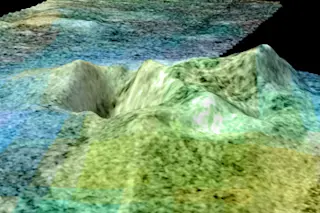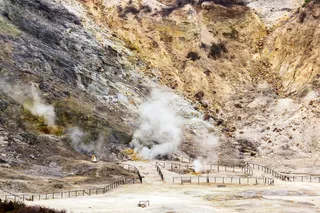Saturn's moon Titan has lakes on its surface and a thick atmosphere, but there's one more way this cold, distant world is like the Earth: It appears to have volcanoes—though they're a little chillier than Eyjafjallajökull. Scientists have long suspected and presented some evidence that Titan could have these features, and this week at the American Geophysical Union meet-up, researchers presented a finding from the Cassini spacecraft that they say is the best evidence yet of a Titanic volcano.
"We finally have some proof that Titan is an active world," said geophysicist Randolph Kirk of the U.S. Geological Survey, who presented the findings. [NPR]
The place is called Sotra. It may have the look of an Earth volcano—a 3,000-foot-tall mountain with a crater in the middle—but this mountain isn't erupting with liquid hot magma. The surface of Titan is nearly -300 degrees F, and the cryovolcano could be erupting water ice and ammonia.
Earth's interior is divided into distinct layers of rock and liquid magma. When this molten rock erupts through the planet's crust, it's known as volcanism. Titan's volcanism is more complicated because beneath the moon's surface lies a layer of ice. Even a small amount of internal heat could create molten ices. Because the liquid would be less dense, it would force its way to the surface. The result would be a massive eruption of slushy liquid and gases similar to what scientists have seen on other icy moons. [New Scientist]
But there's a lot astronomers still don't know about these formations, according to planetary scientist Jeffrey Kargel: whether the eruptions are slow and gentle or quick and violent, whether Titan's volcanism is still going or has died out, or what the texture of the flows is really like.
He said that if the lavas were rich in hydrocarbons, they could have the look of softened asphalt, candle wax or even polyethylene. "There are many unanswered questions and intriguing possibilities," he told reporters. [BBC News]
Earlier this year, the Venus Express spacecraft beamed home evidence that the second planet was recently geologically active
, and could be still. And we know about the water ice plumes on Saturn's moon Enceladus
and the volcanism of Jupiter's moon Io
. Some astronomers still doubt
the Titan volcano story, but the solar system keeps hinting to us that it has been—and may still be—a more active place than many people ever dreamed. Related Content: 80beats: Simulated Titan Atmosphere Produces Life’s Building Blocks
80beats: Saturn Spectacular: A Moon With Fizzy Oceans, Ring Tsunamis, and More
80beats: Weird Chemistry on Titan *Could* Be a Sign of Methane-Based Life
80beats: New Evidence for Ice-Spewing Volcanoes on Saturn’s Moon Titan
80beats: Volcanoes on Venus Could Be Alive & Ready to Erupt
Image: NASA/JPL-Caltech/USGS/University of Arizona














